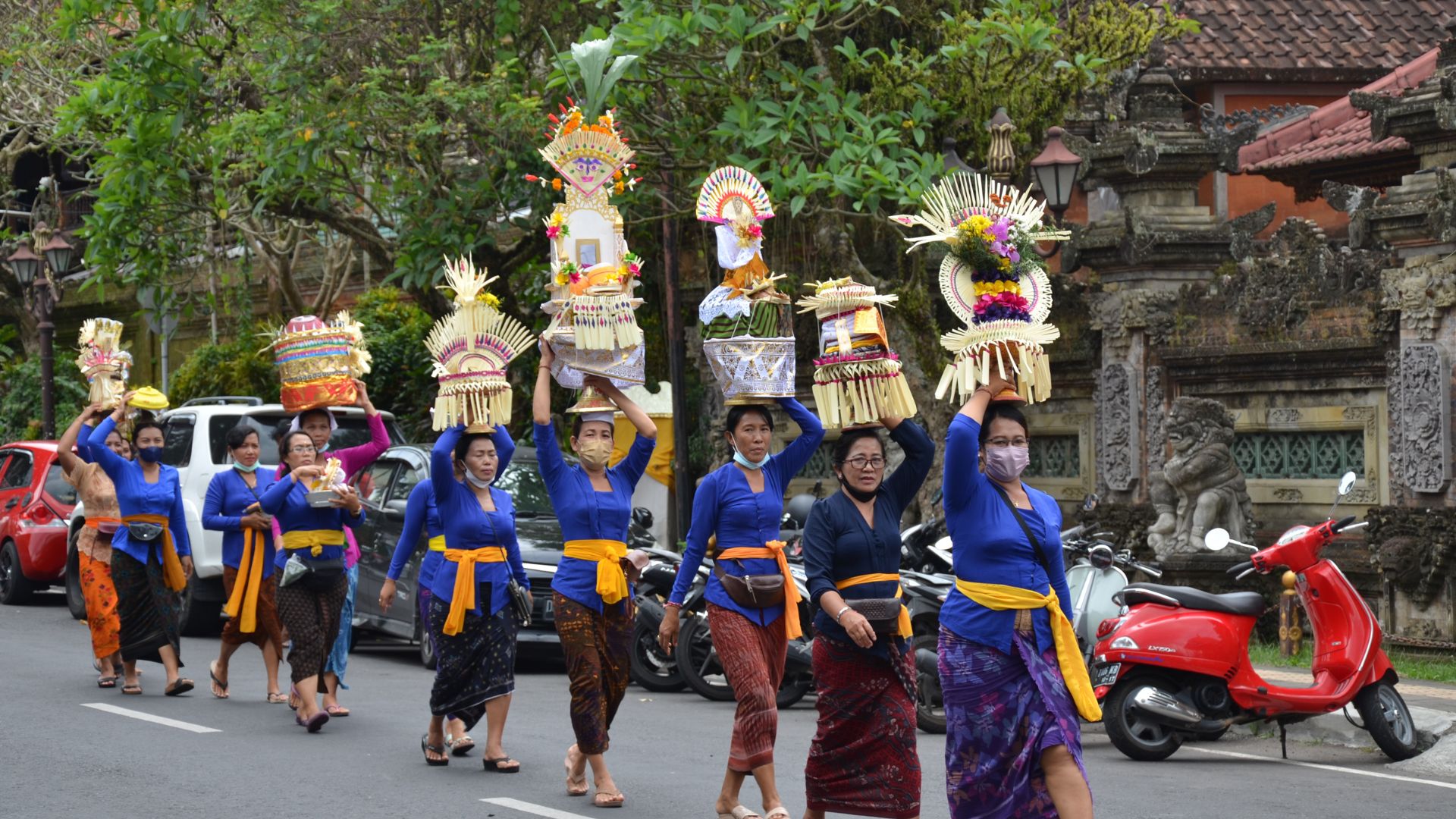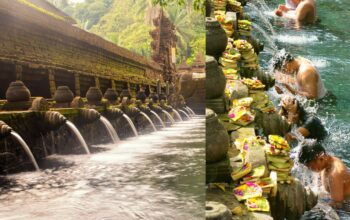If you’ve ever lived or vacationed in Bali, you might have heard the term Tri Hita Karana. This name often appears in tourist spots, temples, schools, and even hotels. But what exactly is Tri Hita Karana? And why is it so important to the Balinese people?
General Questions
What is Tri Hita Karana?
Simply put, Tri Hita Karana is a Balinese philosophy of life that aims to maintain balance and harmony. The word “Tri” means three, “Hita” means happiness, and “Karana” refers to the cause or source. So, when combined, it roughly means “three causes of happiness and balance in life”.
This concept is not just a slogan; it has truly been a guiding principle for Balinese society from ancient times until now. Tri Hita Karana teaches that happiness comes from maintaining good relationships in three key areas: with God, with fellow human beings, and with nature.
What is the meaning of Tri Hita Karana in the daily life of Balinese society?
For the people of Bali, Tri Hita Karana is not merely a philosophy learned in school or textbooks; it is truly practiced in daily life. This principle forms the basis for many aspects—from how they worship and interact with neighbors to how they treat the environment.
The main meaning is that life cannot be solely about oneself. We must be in harmony with these three elements. If our relationship with God is good, our relationship with others is peaceful, and we do not harm nature, then life feels more serene. For example, during traditional ceremonies, Balinese people not only pray but also gather with neighbors, share food, and certainly do not leave trash indiscriminately. Everything is done with the intention of maintaining harmony among the elements of life.
How is the concept of Tri Hita Karana applied in daily life?
Although it seems philosophical, Tri Hita Karana is very down-to-earth. Here are some examples of its application in daily life:
Relationship with God (Parahyangan)
Every morning or evening, many Balinese take the time to pray. There’s no need to go to a large temple—it can be done even at home. They also diligently make canang sari (small offerings of flowers and leaves) as a form of gratitude.
Relationship with Fellow Humans (Pawongan)
Balinese people are known for being friendly and communal. When there is a ceremony in the village, all residents usually help, whether it’s cooking, cleaning, or organizing the event. Mutual help and harmonious living are important parts of this value.
Relationship with Nature (Palemahan)
Nature is not just a dwelling place but also a source of life that must be preserved. Balinese society deeply respects mountains, seas, and forests. Many also engage in mutual cooperation (gotong-royong) to clean the environment or create gardens at home. All of this is done not because of government regulations, but because it has become part of their culture and conscience.
What are the three main elements of Tri Hita Karana?
As mentioned, Tri Hita Karana consists of three main relationships that are the pillars of a happy life:
- Parahyangan – Relationship with God. Examples include praying and participating in religious ceremonies.
- Pawongan – Relationship with fellow human beings. This is seen in how we interact, help neighbors, and live in society.
- Palemahan – Relationship with the environment or surrounding nature. For example, maintaining cleanliness, not littering, or caring for plants.
If these three things are kept in balance, then life feels more peaceful and happy. It is no wonder that many say Tri Hita Karana is a very valuable cultural heritage, even highly suitable for application in the modern era.
Contextual and Philosophical Questions
If we delve deeper, Tri Hita Karana is not just about living harmoniously or Balinese tradition. Beneath it all are profound meanings that touch upon the spiritual side and the philosophy of life. Let’s discuss some important questions that often arise when talking about this concept more seriously, yet casually!
What is the relationship between humans and God in Tri Hita Karana?
In the teachings of Tri Hita Karana, the relationship between humans and God is called Parahyangan. Essentially, humans are not standalone beings. There is a higher power—God—who is the source of life and deserves respect. For the Balinese people, establishing a connection with God is not just about going to a large temple or attending major ceremonies. Even by making canang sari every morning, they show gratitude and reverence. This is a simple yet meaningful way to remember that all we possess comes from the Almighty. Therefore, this relationship is crucial because it forms the foundation of a balanced life. If we forget to be grateful or become arrogant with what we have, life can feel empty and restless.
What is the meaning of the relationship between humans and fellow humans in this teaching?
The second element in Tri Hita Karana is Pawongan, which refers to the relationship among human beings. This is not merely about politeness or formality. In Balinese culture, living in a community is like a single body—interconnected and interdependent. An example can be seen in the tradition of gotong-royong (mutual cooperation) during village ceremonies. No one is paid, but everyone sincerely helps because they feel it is part of living together. If a neighbor experiences misfortune, people will come to help without being asked. The meaning is clear: humans cannot live alone. We need to care for, respect, and look out for each other’s feelings. With healthy social relationships, life becomes lighter and more meaningful.
Why is it important to maintain harmony with nature according to Tri Hita Karana?
Now, the third element is Palemahan, which is the relationship between humans and the environment. This part is often overlooked, yet it is incredibly important. For the Balinese, nature is not just a dwelling place, but also possesses a “soul” and must be respected. For instance, the sea is considered sacred, mountains are revered, and forests are protected. They are aware that if nature is damaged, humans will also suffer. Therefore, many traditional activities are carried out with environmental preservation in mind. Even in construction, Balinese people usually consider the “character of the land” and “auspicious directions” before building a house or a temple. So, maintaining nature according to Tri Hita Karana is not just about cleaning up, but also about spirituality. Nature and humans are interdependent.
What are the spiritual values contained in Tri Hita Karana?
Behind the concept of Tri Hita Karana, there are many spiritual values that we can derive. These are not only for Balinese Hindus but are actually universal and can be applied by anyone. Some of the most palpable values include:
- Gratitude: Appreciating what one already has and always remembering God.
- Harmony: Striving to live peacefully, both with fellow human beings and with the surrounding nature.
- Tolerance and care: Not being selfish, but always caring for others and the community.
- Ecological awareness: Not damaging the environment, because one is aware that nature plays an important role in our lives.
These values make life feel more complete. It’s not just about material things, but also about a calm inner self, a clean heart, and a balanced life.
Questions Related to Balinese Culture and Customs
Tri Hita Karana is not just a philosophical concept or a theory of life. In Bali, this teaching has become integrated into the daily culture and life of the community, including in physical forms such as temple buildings, village arrangements, and traditional customs. Here are some interesting points about how Tri Hita Karana influences Balinese culture from the perspective of customs and social structure:
How does Tri Hita Karana influence the architecture of temples and village layout in Bali?
If you’ve ever walked around a traditional village in Bali, you’ve certainly noticed the neat and structured layout. It turns out this isn’t arbitrary! The concept of village and temple arrangement in Bali is heavily influenced by Tri Hita Karana, especially in maintaining the balance between humans, God, and nature.
For example, temples or sacred places are usually built in the northern or eastern part of the village, which are considered higher or more sacred directions. In the central part, there is a residential area for citizens, where they live side by side. Then, in the southern or western part of the village, there are usually rice fields, rivers, or burial areas. This arrangement is not just about aesthetics or inherited customs; it carries deep meaning. Placing places of worship at the highest point shows respect for God. Living and socializing areas in the center symbolize relationships among fellow humans. Meanwhile, nature, such as rice fields or rivers, is preserved and placed harmoniously as a form of respect for the environment.
Is Tri Hita Karana also reflected in Balinese traditional ceremonies?
The answer is: Absolutely! Almost all traditional ceremonies in Bali have elements of Tri Hita Karana within them. From small ceremonies at home to large village ceremonies, all strive to maintain spiritual, social, and ecological balance. For example, during ceremonies like Galungan, Kuningan, or Melasti, the community not only prays to God (Parahyangan) but also gathers and cooperates among citizens (Pawongan). Even in Melasti, they go to the sea to cleanse sacred symbols, while also purifying nature (Palemahan). In every procession, there are values of mutual cooperation, togetherness, and respect for nature. So, it can be said that Balinese traditional ceremonies are not just rituals but also practical applications of the Tri Hita Karana teachings.
How does Tri Hita Karana play a role in shaping a harmonious Balinese society?
One of the reasons Bali feels peaceful and warm is not only because of its beautiful scenery but also because its society lives in harmony. And the secret lies in Tri Hita Karana. This concept teaches Balinese people not to think only of themselves. They are encouraged to live in harmony with others, always respect nature, and remain spiritually connected with God.
Modern Applications and Sustainable Development
Tri Hita Karana is not just an ancient philosophy confined to lontar manuscripts or taught in schools. In Bali, this teaching continues to live and evolve with the times, especially in the tourism and development industries. This indicates that traditional values can indeed be a strong foundation for a sustainable future.
How is Tri Hita Karana integrated into modern tourism and development in Bali?
One of the most interesting aspects of Tri Hita Karana is how it is adapted and applied in various modern sectors, especially tourism. Bali, known as a world tourist destination, manages to maintain its cultural identity amidst rapid development.
Sustainable Tourism Villages
Many villages on Bali have transformed into “sustainable tourism villages.” These villages not only offer beautiful natural views or unique cultural experiences to tourists but also apply the principles of Tri Hita Karana in their management. For example, some villages implement natural farming and wise water management, which is even recognized by UNESCO. This showcases how development can still run without damaging cultural values and the environment, as long as there is awareness and a spirit of mutual cooperation.
Eco-Friendly Hotels and Resorts
Many hotels and resorts in Bali now adopt environmentally friendly concepts that reflect Tri Hita Karana. They integrate local architecture, use sustainable materials, manage waste wisely, and actively involve local communities in their operations. This allows tourists to enjoy luxury while participating in preserving the environment and supporting the local economy.
Cultural Festivals and Environmental Programs
Cultural festivals like the Bali Spirit Festival or Ubud Writers & Readers Festival not only celebrate art and spirituality but also support local communities and address social issues. Additionally, environmental preservation programs, such as beach clean-ups involving tourists, businesses, and residents, unite all elements of society for the same goal: keeping Bali’s nature pristine.
All the examples above show that development can indeed proceed without harming cultural and environmental values, provided there is awareness and a spirit of mutual cooperation.
Conclusion
Tri Hita Karana is not just an ancient philosophy written on lontar or taught in schools. In Bali, this teaching continues to live and grow with the times, including in the tourism and development industries.
By making Tri Hita Karana its foundation, Bali has successfully shown that economic growth can go hand in hand with cultural and environmental preservation. From tourism villages, eco-friendly hotels, to cultural festivals, everything proves that local values can be a strong foundation for a sustainable future.
So, if you visit Bali, you are not just enjoying the beautiful nature or unique culture, but also becoming part of the great harmony built by its people through Tri Hita Karana.












